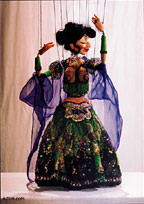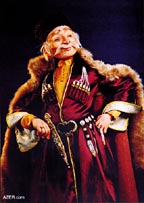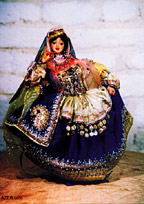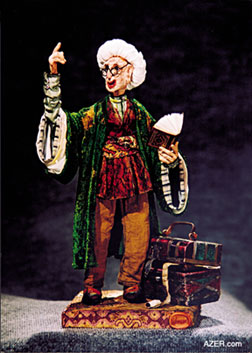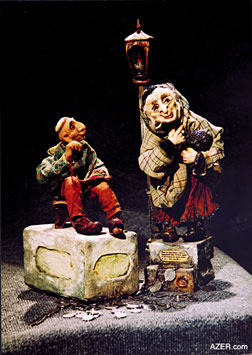|

Autumn 2004 (12.3)
Pages
38-43
The Wink of a Doll
Capturing the Spirit of Creation
by Elmira
Abbasly
  They're
not just cutesy dolls, they're replicas of characters that have
been meticulously researched and designed-whether beautiful girls
dressed in national costume or an entire entourage comprising
a camel caravan. And they all have their roots in the Old City
where Elmira Abbasly spent her childhood, listening to stories
her grandmother used to tell. They're
not just cutesy dolls, they're replicas of characters that have
been meticulously researched and designed-whether beautiful girls
dressed in national costume or an entire entourage comprising
a camel caravan. And they all have their roots in the Old City
where Elmira Abbasly spent her childhood, listening to stories
her grandmother used to tell.
I've never studied
art formally. I've basically learned the art of doll-making entirely
on my own. At the university, I majored in Geography. But I had
this love inside me to create dolls, and so I started learning
on my own, step by step. This is where I am today. It has taken
me 16-17 years to learn everything that I know today. As an adult,
I can say that Life itself has been my teacher. I learn from
everywhere.
I believe that each individual has a great treasure inside of
himself that God has put there. I'm one of those fortunate people
who has been able to draw upon this treasure. God gives such
a package to everyone. I think everyone can draw upon great resources
inside themselves-a Divine Essence, you might say. Of course,
not everyone is able to. Maybe that was God's gift to me to enable
me to find mine. There is so much creativity inside me. It's
impossible for me to express it all.
I can't say that I really chose to express my creativity by making
dolls. It's just something that opened up to me. It seems that
everybody loves dolls-both adults and children, both men and
women. It seems a great energy emanates from them. When I'm making
the dolls, I try to do it with so much love and care so that
these characteristics get passed on to others as well. I want
the people who see these dolls to feel these things.
The first doll that I remember as a child was when I was three
or four years old. My uncle brought me a doll from Moscow. I
guess I've loved dolls ever since. And now I make them myself.
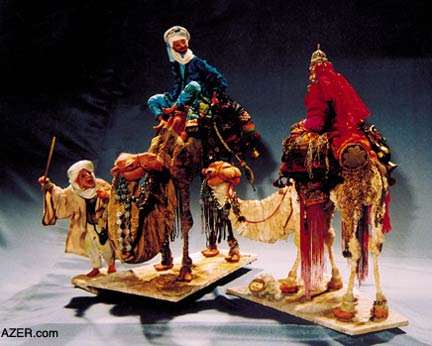
Above: Not
only does Elmira create dolls wearing national costumes, lately
she has been designing camel caravans. Everything is handmade
from the faces,
hands and to the costumes and jewelry.
Camels
My work is not just confined to dolls in traditional dress, or
characters that I've known from childhood growing up in Baku's
Old City; lately I've been making camel caravans.
Why the infatuation with camels? Why do they figure in so much
of my work these days? Well, I've been studying camels quite
a bit lately before trying to tackle to design them. Of course,
it's impossible to learn everything. I've visited zoos in Baku
and Moscow. I've studied so many photos.
But I chose camels for a specific reason. It's not just that
they traveled the silk and spice routes through the region of
Azerbaijan centuries ago. I'm trying to express the inner nature
and symbolism of the character or, in this case, this beast of
burden. For me, the camel is a robust and extremely patient animal.
Not every animal can survive crossing the vast desert and endure
its hostile climate. But the camel can. It carries every load,
every burden.
For me the desert is an allegory. To pass through the desert
is like passing through life-meaning to live your life and be
able to understand it. So I try to address this theme. It seems
to me that there's something in the character of the camel that's
like me. The camel is wise and patient; it has the capacity to
bear many hardships. It has an inner strength and power. Actually,
it's quite an amazing animal. I've written a little verse about
this creature. It goes like this:
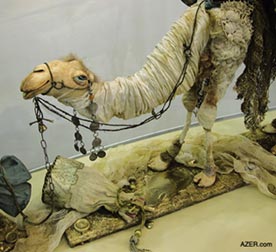  I'm
simple in human life. I'm
simple in human life.
I'm as simple as a camel.
I carry, I lift, I help.
In the journey of life, I am a traveler
I plod along even when I'm exhausted;
And when I'm white and clean,
Dear people, I lighten this road for you,
This sacred road.
Of course, in
legends and beliefs, a light-colored camel is considered sacred.
I'm in the process of working on another caravan right now in
my workshop. It will be rather large. I'm making a prince and
his wife who are making a journey to visit his father. The caravan
is full of valuable gifts.
Magical workshop
Most of the items that I use are things that I make myself. My
workshop is like a magical room full of so many remnants and
scraps of material and jewelry. I never discard anything. I even
have a few birds' nests that I've collected. One of these days,
the twigs and straws from them will become part of the design
for one of my figures.
Sometimes my friends give me items. Sometimes I buy them myself.
I have so many things just lying around that are waiting to be
transformed into something beautiful.
If you believe in magic, you'll understand that material things
themselves find me. I'll be thinking of making something specific
and then, suddenly, the next day somebody drops by and brings
something related to it-a piece of material or a book to research
it more deeply.
God (or whatever you want to call Him) can read our thoughts.
We are in some sort of communication with him. And if you're
honest and clean in front of Him, your thoughts and wishes will
be realized, even in this material world. It doesn't matter what
your religion is. You just have to have that connection.
I feel like I know the language of birds, plants and material
things. God directs people to bring things or say things that
you need. Every person knows everything. Everything is encoded
within us.
Ichari Shahar
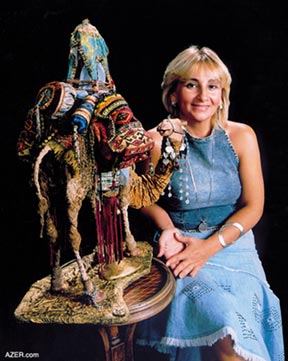  I grew
up in Ichari Shahar in the late 1950s and 60s, listening to my
grandmother's tales. Virtually all of my works relate to the
Old City, which was the heart of life in Baku up until the end
of the 19th century and beginning of the 20th century. I have
such a great nostalgia for my childhood. I grew
up in Ichari Shahar in the late 1950s and 60s, listening to my
grandmother's tales. Virtually all of my works relate to the
Old City, which was the heart of life in Baku up until the end
of the 19th century and beginning of the 20th century. I have
such a great nostalgia for my childhood.
Left: Elmira Abbasly is a
self-taught artist who grew in Baku's Old City, which she says
has immensely
shaped her art. She tries to convey the essence of what she believes
about life in her dolls.
Things have changed a lot now. I'm not saying that it's bad that
things change. Life is always evolving and dynamic. You can't
stop that. But I look back on my childhood with longing.
Most of the dolls that you see here are the epitome of people
I came to know when I was growing up there-the granny always
engaged in gossip, the shoemaker, the mullah on the street corner.
Ichari Shahar was such a unique place in which to grow up as
a kid. First of all, the people were always so kind and friendly
there. People were very tolerant towards each other; they were
used to community living. Everyone always kept their homes open.
No one locked their doors. You were always surrounded by people.
Even when you thought you were alone, others who could help you
were only an earshot away.
In the early afternoon, you could walk through the lanes and
alleyways and smell what were being prepared for dinner. In the
past, the women - especially the grandmothers who weren't working
- would prepare traditional dishes like kufta bozbash (meatball
soup), badimjan dolmasi (stuffed eggplant) and dushbara (soup
with dumplings). Then there was pilaf and fisinjan (sauce for
chicken made from crushed walnuts and pomegranate concentrate).
In the afternoon the streets would be full of children playing.
Grandmothers would be making dinner; grandfathers would pass
the time playing backgammon, chess or dominos.
My grandmother had many neighbors living in her apartment. I
especially remember one old kind Russian lady living on the first
floor. The doors of all those neighbors were never locked. I
could walk in anytime. For example, on days when I didn't have
to go to school, if I got bored, I could drop in on the neighbors
unannounced. If they happened to be eating, they would invite
me to join them.
In the evenings, everybody would go out of their houses and meet
in the alleyways. Old ladies would sit on benches or steps and
chat and gossip. Everybody would take their tea and drink it
with others in the courtyards and walkways. I have so many fond
memories about Ichari Shahar.
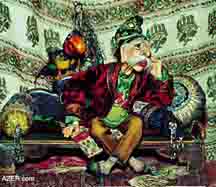 |
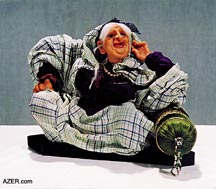 |
Above: Many of Elmira Abbasly's
dolls are based on characters from childhood memories of growing
up in the narrow, winding streets of Baku's Ichari Shahar (Old
City). Here the old man and the gossiper.
They used to
make a lot of movies in Ichari Shahar. You would step outside
of your house and suddenly see people walking around who were
wearing such strange costumes. Once I remember seeing some ladies
dressed up like Africans, carrying fruits on their head.
You won't believe it but my favorite place in Ichari Shahar was
the kerosene shop. I loved the smell. The building was constructed
in a unique way. There was a big metal pool in the center of
the shop. Ladles of various sizes were hanging from it. The shopkeeper
would choose a ladle according to the amount of kerosene that
you wanted and he would pour the kerosene directly into your
container from the pool. When I was a child, I used to think
how I would love to grow up and sell kerosene!
These days if someone tells me that they're from Ichari Shahar,
it means that somehow we're related. It was like one big family.
Everybody knew each other. Everybody in Ichari Shahar was somehow
related-cousins, aunts, uncles, grandparents. Somehow, everyone
is related - at least distantly. Everybody in Baku used to live
in Ichari Shahar. Of course, the city grew and people had to
move outside the citadel walls.
There's no doubt that growing up in Ichari Shahar has deeply
influenced my life. In fact, I can't imagine having a different
childhood. How could I not have grown up there? Ichari Shahar
for me wasn't just a small center that extended just a few blocks;
it was a large city. In fact, it was my whole world. And what
a fascinating world it was!
Bathhouse
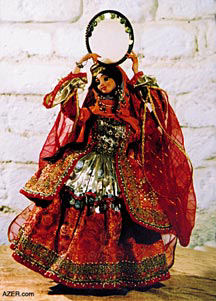  Take
the ritual of going to the bathhouse. It's not like now when
you jump into the shower for three minutes. No. Going to the
bathhouse was a ritual that took place once a week and used to
occupy almost the whole day. First of all, you had to make preparations,
gathering the things that you would use there, like fresh, clean
clothes to wear after you bathed. Then you had to prepare food
to take because the children would get hungry. Take
the ritual of going to the bathhouse. It's not like now when
you jump into the shower for three minutes. No. Going to the
bathhouse was a ritual that took place once a week and used to
occupy almost the whole day. First of all, you had to make preparations,
gathering the things that you would use there, like fresh, clean
clothes to wear after you bathed. Then you had to prepare food
to take because the children would get hungry.
Left: The tiniest details
are handled with minute attention and care. Here a dancer, dressed
in a traditional costume of Azerbaijan.
The bathhouse was a central meeting place for people. You didn't
go there just to bathe. You would meet other women and chat and
gossip. It served other purposes as well, like being an excellent
place where mothers could choose brides for their sons.
In our society, we judge people by their clothes but in the bathhouse,
naked, without clothes, everyone is equal. At the bathhouse,
everybody is in an absolutely open situation, wearing no clothes.
So you can see any defects a girl might have. Nothing is hidden.
Besides, if a person has a bad character, you'll detect it immediately.
The bathhouse gives you the chance to study a young woman in
the context of other female members of the household. You can
judge the girl's character and get a fairly good idea of what
kind of a wife she would make just by observing her mother. Since
you would spend most of the day there every week, you have sufficient
time to get to know any prospective bride.
It was always so noisy in the bathhouse. There was the noise
of buckets clinking, the splashing of water, women chatting,
kids running all over the place. Men never took the children;
it was always the women - never mind if the child was a girl
or a little boy as boys always accompanied their mothers up to
a certain age.
In addition, there was always an echo in the bathhouse because
of the construction of domes. We have an expression, "Their
house is like a woman's bathhouse", meaning that it's quite
noisy and chaotic.
But after bathing you would feel so clean. The dust of the city
all gets washed off. There's something else that I love about
bathhouses - the water never runs out. There's so much water
there. In Baku, you often have to be so careful because the water
supply gets depleted, but at those old bathhouses, there were
never any restrictions. You could throw buckets and buckets of
water over yourself and still there would be so much water left.
There are large stones that are heated up and when you toss water
on them, steam rises up - like a hot sauna. It's amazing.
There are still two famous bathhouses open in the Ichari Shahar.
One is close to the Baksovet Metro Station and the other is close
to the Italian Embassy. They both still operate today. The others
that we used to visit as children have been closed.
When you would walk back home from the bathhouse, everybody knew
where you had been - you, with the flushed red face and bucket
in your hand. The neighbors would call out: "Hamisha tamizlikda,"
meaning, "May you always be clean." I like that; it's
a lovely expression. Can you imagine everyone in the neighborhood
knowing that you were coming from the bathhouse?!
No Secrets
Below: Elmira Abbasly also
creates marionette dolls and made an entire set for Uzeyir Hajibeyov's
"Arshin Mal Alan" (Cloth Peddler). Note the incredible
attention to detail in both costumes and facial expressions.
There really weren't many secrets in Ichari Shahar. You were
living so close to each other all the time. You felt cushioned
by love because you knew everybody. People accepted you as family.
It was like everybody was involved with the lives of others.
We knew so much about each other.
As teenage girls, whenever we would go outside the citadel walls,
guys would start to follow us. But whenever we got close to Ichari
Shahar, they would stop. They didn't dare enter Ichari Shahar.
If you wanted to get rid of some pests who were following you,
just walk inside the gates of Ichari Shahar. They would disappear.
They knew better than to walk inside the citadel walls because
our guys always watched out for us.
There were other advantages of living in a closed-knit community
as well. You always used to think twice before doing something
bad there. People were conscious that their behavior and actions
could effect their reputation for the rest of their lives. And
so, being on good behavior was the norm there. There was no way
to shut the door and hide. You were always exposed.
The creative process
Let me describe how I go about making the dolls. When I'm designing,
first of all, of course, I have to come up with an idea. Then
I have to consider what materials and what technical processes
to use.
For example, when I'm creating a camel, obviously, I know that
I'll need a wooden platform on which to set the camel. I'll also
need some sort of frame upon which to build up the shape of the
animal - a skeleton on which to apply cotton and fabric.
As far as my equipment is concerned, I use very ordinary tools:
scissors, wire cutters, pins, needles.
Next, I shape the face, the hands, the feet with a type of modeling
clay. This requires knowing anatomy quite well.
Then I must add color, which ends up being a very time-consuming
and difficult task. Yesterday, it took me several hours just
to paint one doll's eyes. Eyes are so important. They reveal
a person's character - whether flirtatious, cunning or sad. I
usually choose gray or green - a light color - for the eyes.
If I made them black, it would be impossible to express the subtlety
that I want. They would just appear as black dots. But with lighter
colors, I can be much more expressive. I use quash-water paint
- not oil, because, again, I'm looking for delicate colors which
absorb easily into the clay.
Humor
Above: Elmira Abbasly's characterization
of the Molla and other neighborhood characters from childhood
memories growing up in Baku's Old City.
I try to give
some character of coquetry to my dolls - to engage the viewer.
This comes primarily through the eyes. So what? It's just a doll
that was made by human hands, and so I let my fantasy wonder.
I don't want everything to be realistic. I want people to grasp
the essence of each character and catch the humor, which I always
try to inject into my works.
I try to express my attitude towards life in my works and to
me, life is full of humor. I want to create a sense of playfulness.
Some people complain: "A camel can't move like this; it
can't pose like that." And I reply, "So what? I can
create whatever shape I want for the camel. I can do what I want
with it. I want to show that it's possible to break out of a
realistic mold. We all need to fantasize a bit in life anyway.
Then I have to consider what to do for jewelry. If I'm making
a very ornate doll, I'll certainly need to make jewelry as well.
Actually, I create jewelry for the camels as well and even distinguish
between jewelry that will be used with male camels or ones on
which men ride, or jewelry for the female camels or ones on which
females ride.
I make all this jewelry by hand. If I see something interesting,
I buy it and save it for the future. I like to take what one
might consider an ugly piece of metal, and then burn, cut, or
press it and transform it into a beautiful piece of jewelry.
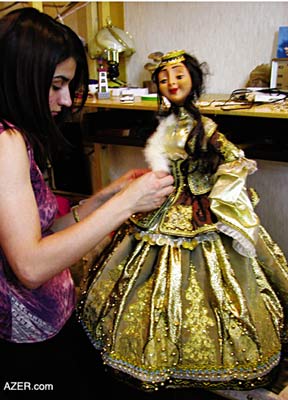  It's
at this stage that the girls who work with me begin to sew the
clothes. I choose colors that are very rich and Eastern. It's
at this stage that the girls who work with me begin to sew the
clothes. I choose colors that are very rich and Eastern.
Left: One of Elmira's assistants
painstakingly sewing a national dress on a doll.
It's
something that I sense inside of me. You can't really learn colors
from looking at books-for example, achieving the color of henna,
or yellow ginger, or unique richness of colors of some of the
other spices that are found in Eastern bazaars.
For one of my character dolls, a vizier (king's assistant), I've
incorporated many different fabrics into his robe. His belt alone
is made up of four different fabrics. Since he works so closely
with royalty, he must be richly decorated. Sometimes my fabrics
are very old and beautiful. Sometimes I use new materials and
dye them. Some cloth is handmade that I've bought from an antique
shop years ago. I'll use every bit of it. Even the threads. Nothing,
absolutely nothing, is discarded.
Sometimes, I feel that it's important to incorporate sound into
the work as well, like putting bells on camels or coins on headdresses.
Reference Books
I have a shelf full of books here that I often consult: books
with national costumes and traditional dress, books from Norway
and Turkey. The Greek Ambassador presented me with a book of
national Greek costumes and I discovered that there is close
similarity to Turkish dress. Then there's the African books.
I research camels from the African books. I want to understand
everything - the desert; how people dress; how they wrap the
turbans over their heads in the dusty, dry desert to protect
themselves from the heat; how camels move; how people balance
themselves on top of these creatures. Everything.
I have books about Azerbaijani carpets as well. From them, I
learn about the juxtaposition of colors, about traditional symbols
and patterns.
Selling the Dolls
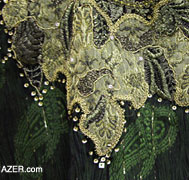  Of course,
I don't finish these dolls in a single day. Sometimes, I work
six months on them; sometimes, even longer. Of course, I'm not
working on a single doll full time. Of course,
I don't finish these dolls in a single day. Sometimes, I work
six months on them; sometimes, even longer. Of course, I'm not
working on a single doll full time.
Left:
The materials
for Elmira's dolls are gathered from everywhere including this
sample of a green silk dress that she found in an antique shop
several years ago. She plans to find a way to use it in the creation
of costumes for some of her character or historical dolls.
I don't know who will buy this caravan that I'm making now. Actually,
I don't even know if anybody will be interested in buying this
set because it's rather large and contains quite a few figures.
But I feel inside of me that I really want to make this, and
so I do it for myself. It's always great when you create something
and then someone comes along who wants to buy it. It's natural
that I want to sell some of my works, as I have to live. I don't
make these dolls just to hold on to them and keep them. Fortunately,
there are always people who want to pay for their pleasure. So
it's natural that I want to sell my works. I hope in the future
that I'll be able to send my works abroad to European and American
galleries. At the same time, my work lets people know that such
art exists and, in my case, that it has its roots in this little
ancient country with a rich culture called Azerbaijan.
Life exists; there is no beginning or end. That's what I feel.
From time to time, we become material beings and do some job
and then we go back to the other life again. I mean that something
spiritual always exists, it never dies. That's what Sufis believe.
And it doesn't have anything to do with believing or not believing.
It's a reality. I feel this myself and so that's the way I live.
I know that there is a heavenly spirit in each creature that
is alive. God created it this way; it can't be otherwise.
There's a non-material spirit that leads us through life. Everybody
has it. And whenever you know that there is this spirit in your
life, you're not afraid of anything. I know that God hears and
sees everything. He is inside us. And now with my dolls, I feel
it is my responsibility to let others know about this marvelous
nature of life through my works.
Gulnar Aydamirova
and Nargiz Rezazade also contributed to this article.
From Azerbaijan
International
(12.3) Autumn 2004.
© Azerbaijan International 2004. All rights reserved.
Back to Index AI 12.3 (Autumn
2004)
AI Home
| Search | Magazine
Choice
| Topics
| AI Store | Contact us
Other Web sites
created by Azerbaijan International
AZgallery.org | AZERI.org | HAJIBEYOV.com
|








